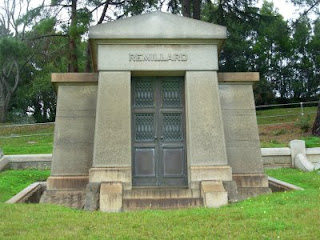

[Gravestone photo by Michael Colbruno]
Plot 9, Lot 30
Henry Durant had been a Congregational clergyman in Massachusetts for several years, and had taught at Yale before his arrival in California at the age of 50 on May 1, 1853 with the dream of establishing a college in the rough, new state. Shortly after his arrival he met Rev. Samuel Willey, another New Englander who had been sent by the American Missionary Society in 1849 to bring Christianity to the miners. Willey had hoped to promote public and private schools, and eventually found a college, but his audience had not been receptive. The two joined forces and, with the support of a committee of ministers, the Contra Costa Academy was opened in Oakland as a college preparatory school.
In the beginning, Henry Durant and three pupils met upstairs in a house at Fifth and Broadway. The rent of $150 a month, plus the $150 a month Durant had to pay the couple who acted as caretaker and cook proved to be more than the school could afford. When the couple did not receive their pay as promised, they took matters into their own hands and opened a bar on the lower floor. Durant was horrified and got the court to order the bar closed. Clearly, something had to be done. He found some property between 12th and 14th Streets and Franklin and Harrison. After they purchased the property, somehow Durant and the committee scraped up $3,000 toward construction of the first building, an amount insufficient to finish it. Worried that the contractor might try to repossess it, the mild-mannered Durant slept in the unfinished building with an axe under his bed. When the building was finished, Durant changed the name to the College School.
According to Beth Bagwell in Oakland, the Story of a City, “Durant’s dream came closer to reality in 1855 when the state granted a charter for the College of California. The college existed on paper for five more years, but beginning in 1857, the College School was preparing students to enter it. By 1859 there were seventy students at the academy from all over the state. They paid $365 a year for tuition and board.”
In 1860, the College of California finally opened in a small building on the campus of the College School, and Durant, who had been principal of the school, became a professor of Greek and Moral Philosophy in the new college. Taking his place as principal of the preparatory school was the Rev. Isaac H. Brayton who, just a few years later, would sell his own hillside property to his fellow trustees of the new Mountain View Cemetery Association. And Dr. Willey who had helped bring the whole idea to life, was made Vice President and Financial Agent. Money problems continued to plague the young institution. Rev. Brayton himself advanced money to build needed buildings, and finally bought the College School which continued to provide students for the new College of California.
While finances were still a problem, help was on the horizon. In response to the full flowering of the Industrial Revolution, in 1862 Congress passed the Morrill Act which granted each state public lands to finance the establishment of agricultural, mining and mechanical arts colleges, later known as “A & M’s”. Such a philosophy was in sharp contrast to the tradition of liberal arts colleges in the east where practical courses were not considered scholarly.
In 1863, the California legislature did a study on the feasibility of establishing a State University, and the next year formally accepted 150,000 acres as California’s portion of public lands under the Morrill Act. In 1866 the legislature agreed to establish an agricultural, mining and mechanical arts college, and the following year decided to locate it in Alameda County.
Here was the ideal answer to the financial dilemma faced by Rev. Durant and the College of California’s Trustees. The state college would have money from the sale of public lands, and the College of California had several buildings, a 10,000 volume library, a faculty and a student body. In addition, the College of California had acquired 160 acres of vacant farm and hill land near Strawberry Creek north of Oakland in an area the trustees subsequently named “Berkeley,” in honor of philosopher George Berkeley, the Bishop of Cloyne. (Berkeley’s famous words, “Westward the course of empire takes its way...” had inspired the trustees as they looked out through the Golden Gate from their property).
In August of 1867, Durant and the trustees offered all the assets of the College of California to the state with the request that the state would forever maintain a college of letters in addition to the schools of agriculture, mining and mechanical arts. On March 23, 1868, (the date still celebrated as Charter Day) the legislature passed an act “to create and organize the University of California.” Professor John LeConte was named acting president, but in 1870, Henry Durant officially became the University’s first president, a post he held until 1872.
Durant was elected mayor of Oakland in 1873-74, in gratitude for the difficult task he had accomplished in bringing a major educational institution into existence in Oakland’s “sphere of influence.” Henry Durant died in 1875, memorialized in a street name, a hotel, and even a bar ---“Henry’s” in Berkeley’s Durant Hotel.
[Biography courtesy of Mountain View docent Barbara Smith]
Subscribe to Michael Colbruno's Mountain View Cemetery Bio Tour by Email








